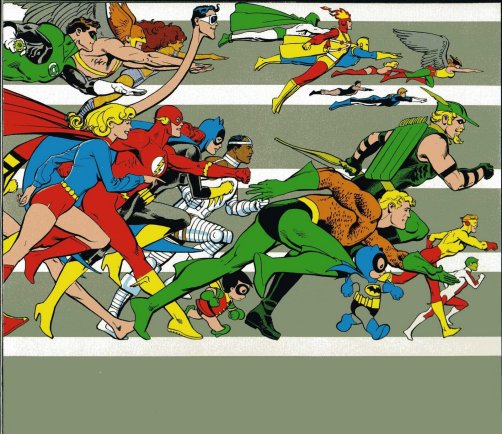
Hello Internet travelers, and welcome to another edition of Into the Bronze Age! It’s time to explore some more classic, Bronze Age DC comics, and we’ve got a pretty interesting trio of titles to talk about this time. We have a significant issue of The Haunted Tank’s harrowing adventures, a cool and unusual issue of JLA, and finally another frantic feature of the Fourth World! Let’s dive right in, shall we?
- Action Comics #406
- Adventure Comics #412
- Batman #236
- Brave and the Bold #98
- Detective Comics #417
- The Flash #210
- Forever People #5
- G.I. Combat #150
- Justice League of America #94
- New Gods #5
- Superboy #179
- Superman #244
- Superman’s Girlfriend, Lois Lane #116
- Superman’s Pal, Jimmy Olsen #143
- World’s Finest #207
Bolded entries are covered in this post, the others will be covered soon.
G.I. Combat #150

“The Death of the Haunted Tank”
Writer: Robert Kanigher
Penciler: Russ Heath
Inker: Russ Heath
Editor/Cover Artist: Joe Kubert
“The Two-Legged Mine”
Writer: Bob Haney
Penciler: Russ Heath
Inker: Russ Heath
Editor: Robert Kanigher
“Hip Shot”
Writer: Sam Glanzman
Penciler: Sam Glanzman
Inker: Sam Glanzman
Editor: Robert Kanigher
“Ice Cream Soldier”
Writer: Robert Kanigher
Penciler: Joe Kubert
Inker: Joe Kubert
Editor: Robert Kanigher
We’ve got a landmark issue of the Haunted Tank this month! For once, the cover doesn’t lie, and when it promises the “Death of the Haunted Tank,” it is being quite literal! After roughly 60 issues, the plucky little M-3 Stuart tank will meet its demise in this issue. And that cover is a pretty good one, in addition to being honest. It’s dramatic, catching a moment, not before disaster strikes, but just as it is striking, which creates a pretty dynamic effect. Of course, Kubert’s stark work adds to the drama of the moment rather nicely.

Inside, our tale begins in what has become normal fashion, with the spectral J.E.B. Stuart offering one of his habitual vague warnings that could really mean anything, as Kanigher continues to not really take advantage of his awesome premise. In this case, the General’s super helpful warning that “things aren’t what they seem” applies to a seemingly crashed German bomber that is actually a trap for the tank. Jeb and company knock it out in a nice two-page splash, but then their ghostly guardian informs them that this was the last time he could “help” them, and bids them farewell.

As Jeb ruminates on this startling turn of events, his crew continue to contemplate his apparent insanity as he seems to speak to empty air. They roll past a depot where other crews are cannibalizing knocked out tanks for parts. There are two things of note in this scene. First, the other crew actually asks how Jeb’s tiny little Stuart constantly knocks out tanks much heavier than it, joking that it must be because it is haunted. Second, we get a shot of this crew, who include Joe, Russ, and Steve, who are given very detailed faces. I feel like this has got to be a reference to particular folks. I’m guessing, and this is just a guess, that the fellow in the middle is Joe Kubert and the one on the right is Russ Heath. I would love to hear from any readers who actually know!

Anyway, possible creator cameos aside, the ghostly guys next run into trouble when they encounter a Jeep full of wounded troops fleeing a fighter. The crew manages to knock the perilous plane out of the sky (more unbelievable feats!), encouraging the team. Yet, their continued faith in the old Stuart meets a much tougher test later on, when they are sent into a hot zone to aid Dog Company.

 The infantry is getting cut to pieces on the banks of a river by a tank and artillery in the woods on the other side. Jeb charges the Stuart into the teeth of the enemy guns, and they get the enemy tank. However, the AT gun tears their little tin box apart piece by piece, and in surprisingly short order, the Haunted Tank dies, though the crew manage to make a frantic escape.
The infantry is getting cut to pieces on the banks of a river by a tank and artillery in the woods on the other side. Jeb charges the Stuart into the teeth of the enemy guns, and they get the enemy tank. However, the AT gun tears their little tin box apart piece by piece, and in surprisingly short order, the Haunted Tank dies, though the crew manage to make a frantic escape.
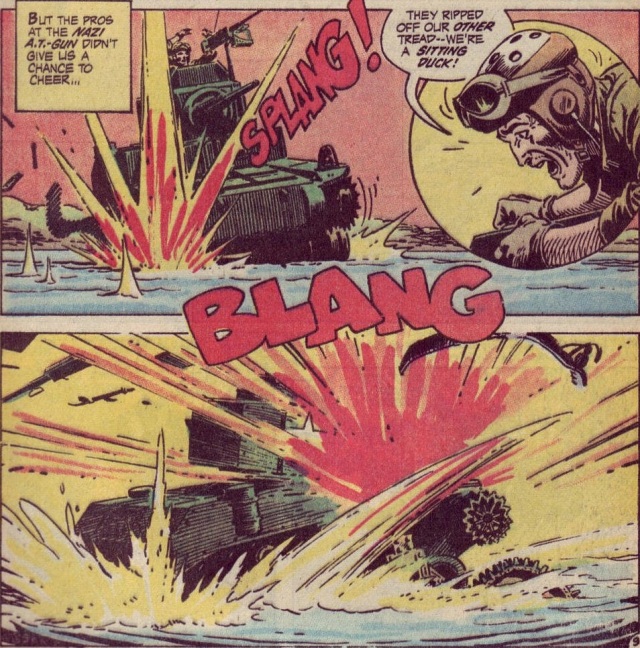
When Jeb and company realize that no more backup is forthcoming, they race to the depot and assemble a new, “Jigsaw Tank” out of cannibalized parts. They take their new makeshift metal monster into combat, just in time to stop two new Nazi tanks charging across the river, and they even manage to clean up the AT gun that killed their previous ride. The story ends with General Stuart returning, and explaining that the tank didn’t matter, only the dedication of the men inside, so the grateful crew christen their new vehicle The Haunted Tank once more.

I actually expected rather more form this tale. It’s a fine, fun story, however unrealistic it is for the guys to assemble a new tank so quickly and easily. Still, I’ve been seeing this cover approaching for some time, and I just expected the death of the tank that had been through so much with the crew to be given a little more weight. Instead, Jeb and co. basically joke about it for a minute, then immediately replace the faithful old girl. Of course, there’s only so much you can do in a 14 page story, but I found myself a bit surprised that Kanigher didn’t make more of the moment. The actual adventures here could have been condensed, with more focus on the central conflict at the river and the loss of the Stuart, which I think would have been more effective.
 As is, the story is really rather forgettable. Of course, Russ Heath’s art remains excellent, perfect for the title. He’s a master of both the dynamic battle scenes and even the quiet, character-centric moments. On a broader note, I continue to be disappointed by the lack of development of the premise. General Stuart leaves the crew for most of the issue, but functionally, it doesn’t actually play out any differently than 90% of the stories we’ve read, as he plays no active part in most plots after his traditional enigmatic warning anyway. Well, missed opportunities aside, I’ll give this solid armored adventure 3.5 Mintuemen. At least Jeb and crew now have a tank that might stand a ghost of a chance against German armor in real life!
As is, the story is really rather forgettable. Of course, Russ Heath’s art remains excellent, perfect for the title. He’s a master of both the dynamic battle scenes and even the quiet, character-centric moments. On a broader note, I continue to be disappointed by the lack of development of the premise. General Stuart leaves the crew for most of the issue, but functionally, it doesn’t actually play out any differently than 90% of the stories we’ve read, as he plays no active part in most plots after his traditional enigmatic warning anyway. Well, missed opportunities aside, I’ll give this solid armored adventure 3.5 Mintuemen. At least Jeb and crew now have a tank that might stand a ghost of a chance against German armor in real life!

Justice League of America #94

“Where Strikes Demonfang?”
Writer: Mike Friedrich
Pencilers: Neal Adams and Dick Dillin
Inkers: Neal Adams and Joe Giella
Letterer: John Costanza
Editor: Julius Schwartz
“The Tarantula Strikes”
Writer: Gardner Fox
Penciler: Bert Christman
Inker: Bert Christman
Editors: Vincent Sullivan and Julius Schwartz
“The Amazing Starman”
Writer: Jack Burnley
Penciler: Jack Burnley
Inkers: Jack Burnley and Ray Burnley
Colourist: Raymond Perry
Letterer: Betty Bentley
Editors: Whitney Ellsworth and Julius Schwartz
Alright! Time for another issue of my favorite comic team’s book! Despite the fact that this title has been so uneven since we’ve started, I still find myself excited about it each month, and this issue features my favorite character….sort of! Sadly, we’ve got a pretty lackluster cover, really. It’s got Deadman’s dramatic pronouncement, but the blank blue background and compressed, box-out cover-space don’t do it any favors, and all the pointless occult paraphernalia in the foreground can’t change that. Of course, the actual art is lovely, as Neal Adams contributes the image, as well as several pages inside! Yet, the biggest trouble with this cover is that it spoils a significant part of the story, which is a shame.

As for that story, it is actually a pretty darn good one. We begin with a wonderfully detailed splash page of the League of Assassins’ leader, the enigmatic Sensei, who is plotting revenge against an unknown JLA member for a previous slight. We join the trio of characters who disappeared from the last arc, Batman, Green Arrow, and the Sea King himself, Aquaman, as they prowl about the waterfront, hunting for an assassin who hunts them in turn. The Bold Bowman spots a flash from the killer’s scope, and the heroes leap into action, quickly corralling the gunman. Yet, the assassin refuses to talk, and the Leaguers are left in the dark about who is the target of the “Demon’s Fang,” the League of Assassins. That’s right, it’s League vs. League!
 Back at the Demon Fang’s headquarters, the Sensei is not pleased that his man has missed his mark, and he summons one of his best, Merlyn, the archer. We get an interesting note of continuity and world-building here, as the League of Assassins are part of Ra’s Al Ghul’s set-up and have been introduced in the Batman books, so it is exciting and surprising to see them here. What’s more, the Demon’s Head, Al Ghul himself, gets name-dropped, as Merlyn mentions that their master has a special interest in their target. Nonetheless, the ancient Sensei is adamant, and the archer is sent on the attack.
Back at the Demon Fang’s headquarters, the Sensei is not pleased that his man has missed his mark, and he summons one of his best, Merlyn, the archer. We get an interesting note of continuity and world-building here, as the League of Assassins are part of Ra’s Al Ghul’s set-up and have been introduced in the Batman books, so it is exciting and surprising to see them here. What’s more, the Demon’s Head, Al Ghul himself, gets name-dropped, as Merlyn mentions that their master has a special interest in their target. Nonetheless, the ancient Sensei is adamant, and the archer is sent on the attack.

Meanwhile, everyone’s favorite sleaze, Morgan Edge, makes another universe-building appearance, and sends Clark Kent out on assignment. There are hints of Intergang’s involvement, and the under-cover Kryptonian brings along a little action figure-sized ace -in-the-hole, the Atom, as the assignment brings him near the last known location of the missing Leaguers. Yet, before they can arrive, their news van is ambushed with arrows! Superman attacks, only to be taken out of the fight by special gadgets prepared by the Demonfang techs, including a gravitational arrow which increases the pull of gravity on the Man of Steel exponentially.

![]() The Atom, after delivering a great pint-sized punch, is also put out of commission by a sonic arrow. Now, if you had told me that Merlyn was taking on a significant subset of the League on his own, I would have said that was silly, but Friedrich actually manages to write his way around the problem of a vastly under-powered villain with some reasonable gadgets. It’s nice to see Superman treated as something other than completely unstoppable, and without recourse to Kryptonite or something completely silly. Is it convenient that Merlyn has trick arrows that can take out these heroes? Yes, but I’ll buy it for the purposes of this story.
The Atom, after delivering a great pint-sized punch, is also put out of commission by a sonic arrow. Now, if you had told me that Merlyn was taking on a significant subset of the League on his own, I would have said that was silly, but Friedrich actually manages to write his way around the problem of a vastly under-powered villain with some reasonable gadgets. It’s nice to see Superman treated as something other than completely unstoppable, and without recourse to Kryptonite or something completely silly. Is it convenient that Merlyn has trick arrows that can take out these heroes? Yes, but I’ll buy it for the purposes of this story.

Unfortunately, our other heroes don’t have much better luck than their fellows, as our original trio finds their captive assassin killed almost as soon as they turn him over to the police. On the arrow that killed him is a note, which declares that “The price of failure in the League of Assassins is death!” It is signed by the mysterious Merlyn, and it is here that we discover that Green Arrow knows our enigmatic assassin. Merlyn was a master archer, and he was Ollie’s first great rival, who embarrassed him in a competition before disappearing, only to emerge now, as a master of a decidedly more deadly discipline.

 The titanic trio set out on Merlyn’s trail, but we have an odd little moment where Batman asks Aquaman if he has enough time, and the apparently confused Sea King responds, ‘sure…uh…why not?” I saw what was coming, and I was a bit annoyed by it, and sure enough, as soon as they reach their destination, a creepy old house that is definitely not a trap, the Marine Marvel passes out. He’s been out of water too long (that darn 1 hour limit can’t go away soon enough!), and I just couldn’t believe Friedrich had put the character in the book just to have him act this stupidly. But, when the Caped Crusader finds a fountain inside and submerges the submarine superhero, things take a much more interesting turn, as the Dark Knight puts Aquaman in a headlock and demands to know….who he is! Just then, the trap springs, and Green Arrow is locked in a vacuum tube!
The titanic trio set out on Merlyn’s trail, but we have an odd little moment where Batman asks Aquaman if he has enough time, and the apparently confused Sea King responds, ‘sure…uh…why not?” I saw what was coming, and I was a bit annoyed by it, and sure enough, as soon as they reach their destination, a creepy old house that is definitely not a trap, the Marine Marvel passes out. He’s been out of water too long (that darn 1 hour limit can’t go away soon enough!), and I just couldn’t believe Friedrich had put the character in the book just to have him act this stupidly. But, when the Caped Crusader finds a fountain inside and submerges the submarine superhero, things take a much more interesting turn, as the Dark Knight puts Aquaman in a headlock and demands to know….who he is! Just then, the trap springs, and Green Arrow is locked in a vacuum tube!


While the hunted heroes investigate the house, the agonized Atom manages to smash the sonic arrow and free himself, and he comes up with a novel way to free the Metropolis Marvel too. He can’t budge the gravity device, but he wraps his belt around it and enlarges the machine until it becomes unstable and explodes! That’s actually a really clever solution, and fitting for the brilliant Ray Palmer. The haggard heroes aren’t yet back at a hundred percent, however, and they must hitchhike towards their allies!


I love the hilarious banality of Superman having to listen to some schmo blather on as he hitches a ride! “Really, I have more important things on my mind, man!”
 Back in the villain-haunted house, the Masked Manhunter can’t break his Emerald ally out of his glass prison, but Superman, recovering enough to take flight and escape their blabbermouth chauffeur, is able to spot the predicament with his super vision and hurl the Atom hard enough to free Ollie. It’s really a nice sequence. Yet, at the same time, Batman has become stuck on the fence that separated him from his fallen friend, a perfect target for Merlyn, who has emerged at last to kill his true target…the Dark Knight, of course! He lets fly, but the stunned Green Arrow recovers rapidly enough to string and fire an arrow just in time to deflect Merlyn’s killing shot! His nemesis salutes such a fine shot, and his carefully calculated chance gone, the magician uses a jetpack built into his quiver to escape. Merlyn himself is now a hunted man, as he reminds the heroes that “the price of failure in the League of Assassins is death!”
Back in the villain-haunted house, the Masked Manhunter can’t break his Emerald ally out of his glass prison, but Superman, recovering enough to take flight and escape their blabbermouth chauffeur, is able to spot the predicament with his super vision and hurl the Atom hard enough to free Ollie. It’s really a nice sequence. Yet, at the same time, Batman has become stuck on the fence that separated him from his fallen friend, a perfect target for Merlyn, who has emerged at last to kill his true target…the Dark Knight, of course! He lets fly, but the stunned Green Arrow recovers rapidly enough to string and fire an arrow just in time to deflect Merlyn’s killing shot! His nemesis salutes such a fine shot, and his carefully calculated chance gone, the magician uses a jetpack built into his quiver to escape. Merlyn himself is now a hunted man, as he reminds the heroes that “the price of failure in the League of Assassins is death!”

 It is then that the “mystery” of Aquaman’s identity is solved in another pair of Adams-penned pages, as the Sea King and the Dark Detective discuss the case. It turns out that Deadman took over the Marine Marvel’s body because the being he serves, Rama Kushna, warned him of an attempt to kill a Justice Leaguer which would upset the balance of the world. He didn’t know who the target was, and the Sea Sleuth was just the first hero to hand, effectively. That’s why he ran himself out of gas (or water, as the case may be), and made various other mistakes. All of this was in revenge for Batman interfering with the Sensei’s attack on Nanda Parbat back in Brave and the Bold #86, apparently, which I must have read but have forgotten.
It is then that the “mystery” of Aquaman’s identity is solved in another pair of Adams-penned pages, as the Sea King and the Dark Detective discuss the case. It turns out that Deadman took over the Marine Marvel’s body because the being he serves, Rama Kushna, warned him of an attempt to kill a Justice Leaguer which would upset the balance of the world. He didn’t know who the target was, and the Sea Sleuth was just the first hero to hand, effectively. That’s why he ran himself out of gas (or water, as the case may be), and made various other mistakes. All of this was in revenge for Batman interfering with the Sensei’s attack on Nanda Parbat back in Brave and the Bold #86, apparently, which I must have read but have forgotten.
Of course, this would be a lot more impressive if we didn’t know Deadman was possessing Aquaman from the cover (even if I did get swept up in the story enough to forget!). Yet, the tale doesn’t end there. It ends with a return to the JLA Satellite, where something is wrong with the teleporter, something that we won’t discover until next issue! Meanwhile, the Sensei has learned his lesson, and the next time he strikes, he shall isolate and destroy his enemy!
 Well, the non-reveal aside, I really enjoyed this issue, despite some trademark overwriting and generally deplorable dialog from Friedrich. It’s a lot of fun, and it is really great to see the universe-building happening in other books filter into the flagship title like this. How interesting must it have been to be reading the Bat-books and JLA, and to see these characters and concepts jump from one title to another? Of course, this makes perfect sense, but it isn’t the kind of thing that you see that much in DC from earlier eras. I imagine it will become more common as we get further into the Bronze Age.
Well, the non-reveal aside, I really enjoyed this issue, despite some trademark overwriting and generally deplorable dialog from Friedrich. It’s a lot of fun, and it is really great to see the universe-building happening in other books filter into the flagship title like this. How interesting must it have been to be reading the Bat-books and JLA, and to see these characters and concepts jump from one title to another? Of course, this makes perfect sense, but it isn’t the kind of thing that you see that much in DC from earlier eras. I imagine it will become more common as we get further into the Bronze Age.
In addition, the story is pretty solidly plotted, with events having a decent logic to them, with characters acting with clear motivations. As I was reading, several story beats seemed off to me, only to be revealed to work perfectly in Friedrich’s plot, which was a pleasant surprise. On another note, the removal of Kryptonite seems to already be paying story dividends, as it has forced Friedrich to come up with a clever way of taking the Man of Tomorrow out of the fight, rather than relying on the formerly ubiquitous mineral. One of the only real downsides to this tale is that Aquaman doesn’t actually get anything to do, which seems like a real waste when he features so prominently in the comic, especially since he isn’t actually Aquaman.
The art is solid throughout, though evincing the standard weaknesses I’ve come to associate with Dillin’s JLA work, though the interpolated Adams pages are beautiful. They are also a bit distracting, as the clash of styles is very noticeable. Nonetheless, this is a fun, interesting issue, with some fascinating world building happening that still manages to include a solid adventure. I’ll give it 4 Minutemen.

New Gods #5

“Spawn!”
Writer: Jack Kirby
Penciler: Jack Kirby
Inker: Mike Royer
Letterer: Mike Royer
Editor: Jack Kirby
“Introducing Fastbak”
Writer: Jack Kirby
Penciler: Jack Kirby
Inker: Vince Colletta
We finally return to the centerpiece of Kirby’s Fourth World epic, and it is a definite improvement over the somewhat understated and disappointing last issue, as the operatic action that suits this book best is back in spades. Our dramatic tale lies beneath a solid, if flawed cover. It’s got a nice, dynamic image in the central brawling characters, though their poses are a bit odd. Yet, their size rather downplays the significance of the massive monster symbolically squeezed into the corner. The orange background doesn’t really help either, especially with Orion’s red costume. Kirby just isn’t producing his best covers for this run, which is a real shame, as the stories really beg for ‘kapow’ images.
 This particular issue begins with Metron, who is traveling through dimensions once more. This time his wanderings take him to one of the most memorable and dramatic settings from Kirby’s Fourth World, the Promethean Galaxy, the last barrier of the Source, where float for all eternity the Promethean Giants who give the place its name. Kirby gives us an amazing, dramatic two-page splash, depicting the size and scope of this strange sight as only the King could. It’s a really striking image. We discover that these giants were beings who tried to force their way to the source, and in return for their hubris, they are bound forever in suspended animation, just short of their goal. I love this concept, wonderfully archetypal, reflecting all of the myths of giants and titans, who have traditionally been associated with the sin of pride and destroyed by the deities they opposed. What a wonderfully Kirby-cosmic treatment of the theme.
This particular issue begins with Metron, who is traveling through dimensions once more. This time his wanderings take him to one of the most memorable and dramatic settings from Kirby’s Fourth World, the Promethean Galaxy, the last barrier of the Source, where float for all eternity the Promethean Giants who give the place its name. Kirby gives us an amazing, dramatic two-page splash, depicting the size and scope of this strange sight as only the King could. It’s a really striking image. We discover that these giants were beings who tried to force their way to the source, and in return for their hubris, they are bound forever in suspended animation, just short of their goal. I love this concept, wonderfully archetypal, reflecting all of the myths of giants and titans, who have traditionally been associated with the sin of pride and destroyed by the deities they opposed. What a wonderfully Kirby-cosmic treatment of the theme.

 Star-sized super-beings aside, once his contemplation is finished, Metron returns to New Genesis, but our story is much more concerned with a humbler sphere, the Earth, where a detective named Terrible Turpin is interrogating Dave Lincoln after the events of the last issue. Turpin has discovered the war between gods that is brewing in his city, and he’s determined to put a stop to it, before the place is leveled in the process. When Lincoln returns to Orion’s human allies, we check in with them, but the Useless Crew continues to contribute little to the plot, other than some exposition and general fretting.
Star-sized super-beings aside, once his contemplation is finished, Metron returns to New Genesis, but our story is much more concerned with a humbler sphere, the Earth, where a detective named Terrible Turpin is interrogating Dave Lincoln after the events of the last issue. Turpin has discovered the war between gods that is brewing in his city, and he’s determined to put a stop to it, before the place is leveled in the process. When Lincoln returns to Orion’s human allies, we check in with them, but the Useless Crew continues to contribute little to the plot, other than some exposition and general fretting.

Fortunately, we don’t waste too much time with them, and we soon rejoin Orion, who was captured by the Deep Six last issue. He’s pinned by a giant clam, where he is taunted by Slig, who also demonstrates the Six’s sinister powers, the ability to mutate living beings with just a touch from his right hand, and to kill instantly with his left! Fortunately for the Dog of War, he is able to free himself with a hidden device after his captor has finished his gloating, though he discovers that the clam is more than meets the eye.

 What follows is a cool sequence as Orion battles his way through various mutated menaces, who all have wonderfully cool Kirby designs (the man just constantly produced awesome creations, even for these little creatures which we’ll never see again!). Finally, the hunted hero discovers a massive, battleship sized cradle, which once held some gargantuan beast created by the Six, but now lies ominously empty.
What follows is a cool sequence as Orion battles his way through various mutated menaces, who all have wonderfully cool Kirby designs (the man just constantly produced awesome creations, even for these little creatures which we’ll never see again!). Finally, the hunted hero discovers a massive, battleship sized cradle, which once held some gargantuan beast created by the Six, but now lies ominously empty.
 Back in the city, Turpin continues his investigation and the Useless Crew continue their fretting, but they are all interrupted by the coming of….Kalibak! Darkseid’s scion arrives with a smash, prepared to spread fear and devastation on Earth! However, Orion is busy elsewhere, so the Cruel one will have to keep for the moment. Back in the undersea caverns, Slig finally finds his quarry amid a pile of smashed guards. Unfortunately for him, the warrior has also found something, his Astro-Harness, and he blasts his foe in the face before proceeding to pummel him pitilessly.
Back in the city, Turpin continues his investigation and the Useless Crew continue their fretting, but they are all interrupted by the coming of….Kalibak! Darkseid’s scion arrives with a smash, prepared to spread fear and devastation on Earth! However, Orion is busy elsewhere, so the Cruel one will have to keep for the moment. Back in the undersea caverns, Slig finally finds his quarry amid a pile of smashed guards. Unfortunately for him, the warrior has also found something, his Astro-Harness, and he blasts his foe in the face before proceeding to pummel him pitilessly.

 It’s another great sequence, and Kirby shows us the savage joy Orion takes in the terrible thrashing he administers, as well as showing us Slig’s beaten face. The King actually manages to make this malicious monster a little pitiful in that moment. Interestingly, Orion’s brutal visage is revealed by the violence of his attack, and he is forced to have Mother Box replace his fallen features, another hint about his origins. Finally, the Dog of War disposes of his fallen foe by tossing him into a pit and sets out in search of the monster the Six have unleashed. We get a glimpse of the beast in a nice splash page, but lacking anything to establish its scale, it’s not as effective as it might be.
It’s another great sequence, and Kirby shows us the savage joy Orion takes in the terrible thrashing he administers, as well as showing us Slig’s beaten face. The King actually manages to make this malicious monster a little pitiful in that moment. Interestingly, Orion’s brutal visage is revealed by the violence of his attack, and he is forced to have Mother Box replace his fallen features, another hint about his origins. Finally, the Dog of War disposes of his fallen foe by tossing him into a pit and sets out in search of the monster the Six have unleashed. We get a glimpse of the beast in a nice splash page, but lacking anything to establish its scale, it’s not as effective as it might be.
 So this is a great, action-packed issue, setting up a lot of what’s to come with Terrible Turpin and Kalibak’s chaotic arrival, as well as the monster unleashed on the seas. There is a lot going on here, and Kirby handles it quite well. While the time spent with Orion’s supporting cast feels wasted, every moment with the warrior’s quest is exciting and dramatic, and the glimpses of the wider mythology with Metron are fascinating. The whole thing feels operatic and earth-shaking in the best ways, like a particularly good issue of the classic Fantastic Four, but elevated by the cosmic overtones and archetypal underpinnings of the Fourth World.
So this is a great, action-packed issue, setting up a lot of what’s to come with Terrible Turpin and Kalibak’s chaotic arrival, as well as the monster unleashed on the seas. There is a lot going on here, and Kirby handles it quite well. While the time spent with Orion’s supporting cast feels wasted, every moment with the warrior’s quest is exciting and dramatic, and the glimpses of the wider mythology with Metron are fascinating. The whole thing feels operatic and earth-shaking in the best ways, like a particularly good issue of the classic Fantastic Four, but elevated by the cosmic overtones and archetypal underpinnings of the Fourth World.

 It’s also fun to see Detective Dan Turpin introduced, as he will later be recast as a tribute to Kirby himself in Superman: TAS, where his bulldog attitude and heroic perseverance make him a fitting match for his creator. On the art front, this issue looks quite good, and it is immediately noticeable that Colletta is gone from the book. Mike Royer’s inks aren’t perfect, but they seem to pick up more detail and generally drown out Kirby’s pencils less. At least so it seems to my inexpert eye. As I said, I love the creativity of the Deep Six’s monster minions. Why no-one has brought the Six back as recurring Aquaman villains, complete with a Kirby-esq monstrous menagerie of mutants is quite beyond me. Missed opportunities aside, I’ll give this exciting adventure 4.5 Minutemen.
It’s also fun to see Detective Dan Turpin introduced, as he will later be recast as a tribute to Kirby himself in Superman: TAS, where his bulldog attitude and heroic perseverance make him a fitting match for his creator. On the art front, this issue looks quite good, and it is immediately noticeable that Colletta is gone from the book. Mike Royer’s inks aren’t perfect, but they seem to pick up more detail and generally drown out Kirby’s pencils less. At least so it seems to my inexpert eye. As I said, I love the creativity of the Deep Six’s monster minions. Why no-one has brought the Six back as recurring Aquaman villains, complete with a Kirby-esq monstrous menagerie of mutants is quite beyond me. Missed opportunities aside, I’ll give this exciting adventure 4.5 Minutemen.
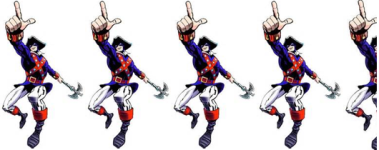
“Introducing Fastbak”

We get another brief Young Gods backup strip in this issue, this one featuring Fastbak, a free-spirited New Genesis youth with a need for speed. Once again, there are only four pages to the strip, so there isn’t really time for Kirby to do much with the character, but we see him lead the New Genesis equivalent of cops, the Monitors (no, not those Monitors) a merry chase as he flies around Supertown at reckless speed.
The aptly named Fastbak is joined by more restless young gods, and when he finally comes to ground, he is given a quick wardrobe change by his friends just in time to sing before Highfather. It turns out that our rebellious friend has the voice of an angel when he’s not busy raising Cain. This was a fun little strip, full of exuberance, energy, and the boundless enthusiasm of youth. With Fastbak and his fellows, Kirby immediately humanizes the New Gods by showing us a fitting parallel to our own youthful foolishness even in their hallowed halls, yet this youthfulness is presented in an inimitable Fourth World fashion. Of course, the King also gives us more great designs both in characters and wild Kirby-tech. I’ve decided I’m not going to rate these backups, as they are really too brief to be judged as full stories.
Well, I will close out this post with Fastbak’s flying feats and bid you all a fond farewell until next time! I hope you enjoyed my coverage of these exciting adventures and that you will join me again soon, for another edition of Into the Bronze Age! Until then, keep the Heroic Ideal alive!
















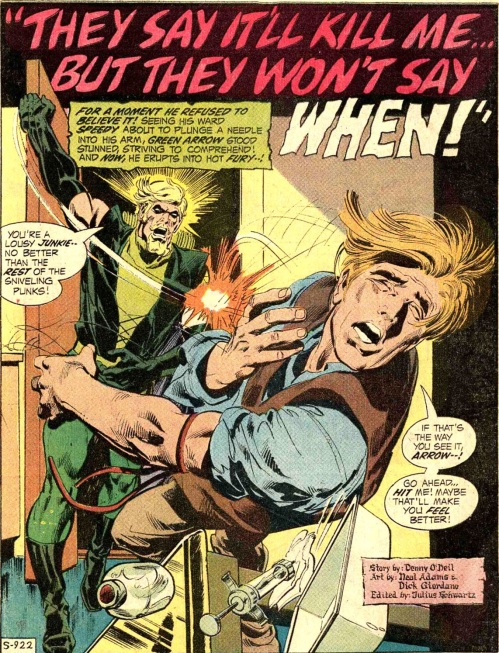
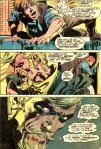
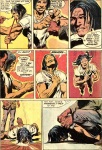

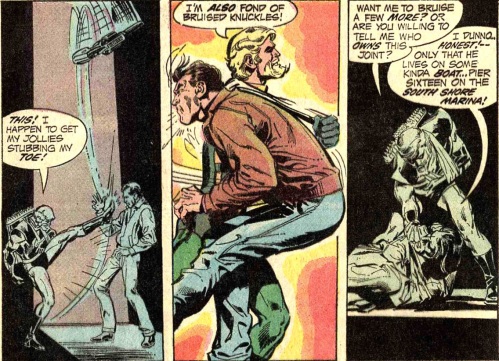
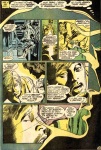

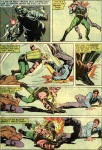
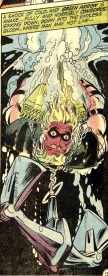
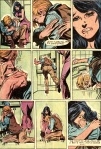
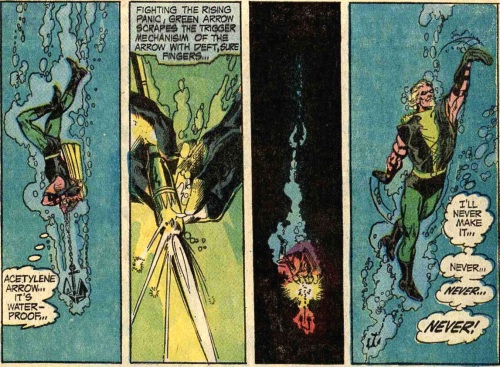
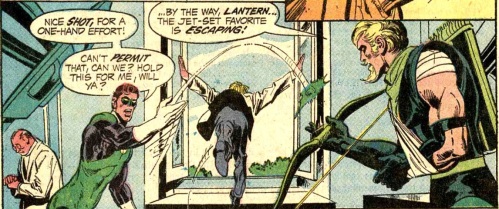
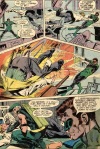

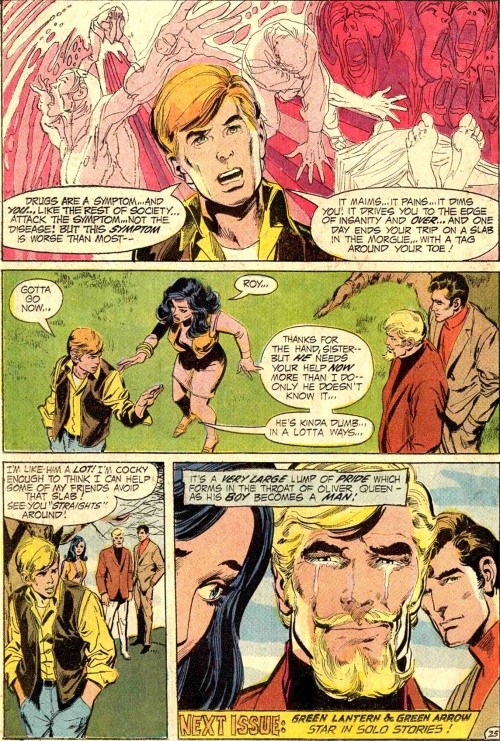
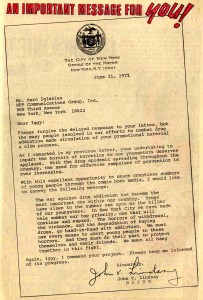
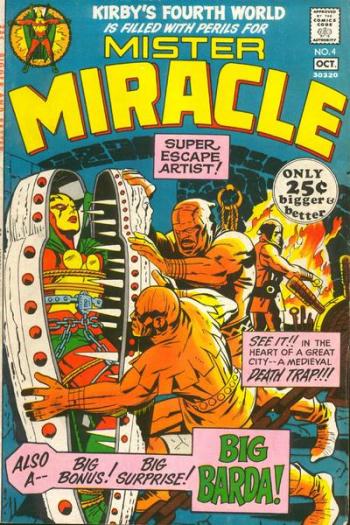
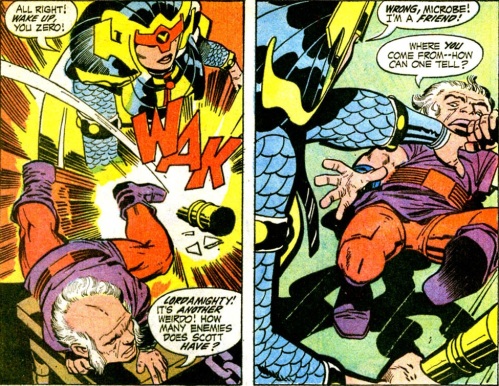


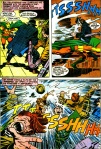
 Suddenly, he’s attacked by refugees from a Robin Hood picture, as a bunch of guys in medieval costumes capture the hero. They drag him into a dungeon, which turns out to be a set in the Galaxy Broadcasting TV studio, conveniently located on this level. Inside is a director, even nuttier than most, who directs his men to kill the interloper so that his death-throes can make for good television! Despite his struggles, Scott is forced into an iron maiden, and all seems lost as the lid slams shut. The whole scene is fun but utterly crazy. It reads like a Fantastic Four issue from the era where Stan and Jack weren’t talking to each other and Stan was thrown into narrative gymnastics in an attempt to explain the bizarre and unrelated images Jack created as his imagination ran away with him. However, this time, there’s nobody to blame for the sudden shift and strange explanation other than Kirby himself. I guess he just wanted to draw an iron maiden, so he shoe-horned the setting in, logic be darned!
Suddenly, he’s attacked by refugees from a Robin Hood picture, as a bunch of guys in medieval costumes capture the hero. They drag him into a dungeon, which turns out to be a set in the Galaxy Broadcasting TV studio, conveniently located on this level. Inside is a director, even nuttier than most, who directs his men to kill the interloper so that his death-throes can make for good television! Despite his struggles, Scott is forced into an iron maiden, and all seems lost as the lid slams shut. The whole scene is fun but utterly crazy. It reads like a Fantastic Four issue from the era where Stan and Jack weren’t talking to each other and Stan was thrown into narrative gymnastics in an attempt to explain the bizarre and unrelated images Jack created as his imagination ran away with him. However, this time, there’s nobody to blame for the sudden shift and strange explanation other than Kirby himself. I guess he just wanted to draw an iron maiden, so he shoe-horned the setting in, logic be darned!
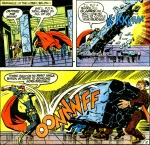

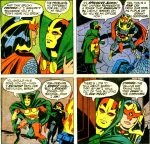



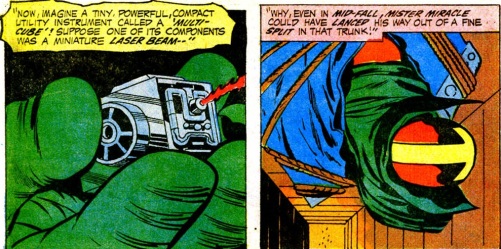
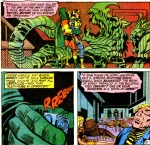
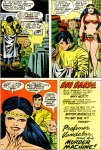
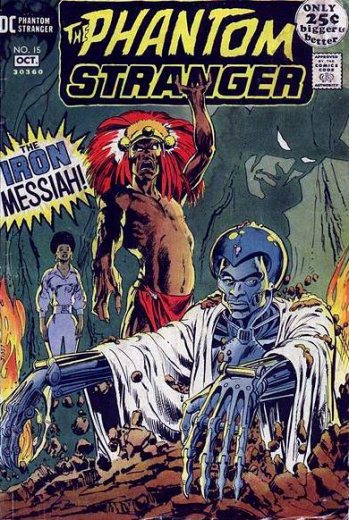
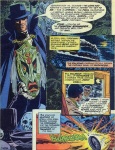

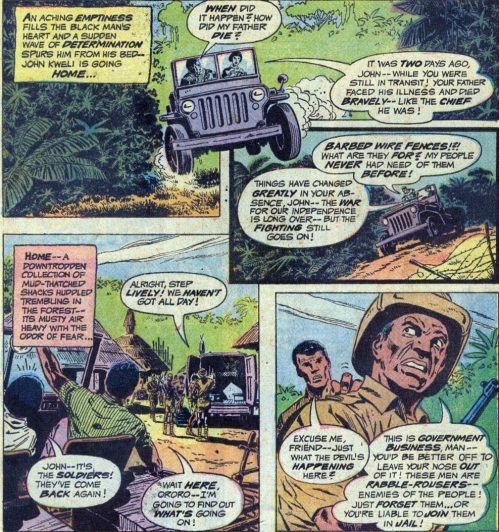

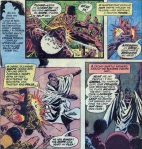



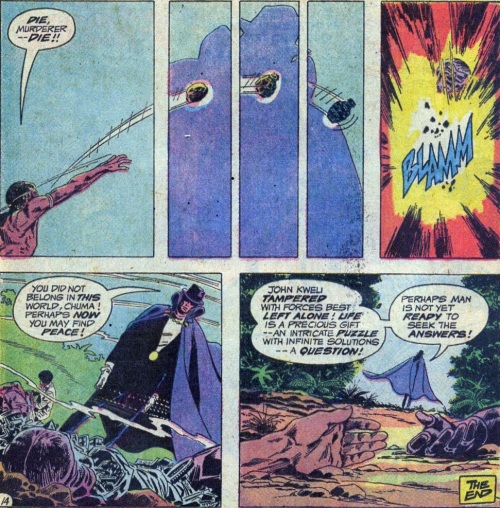

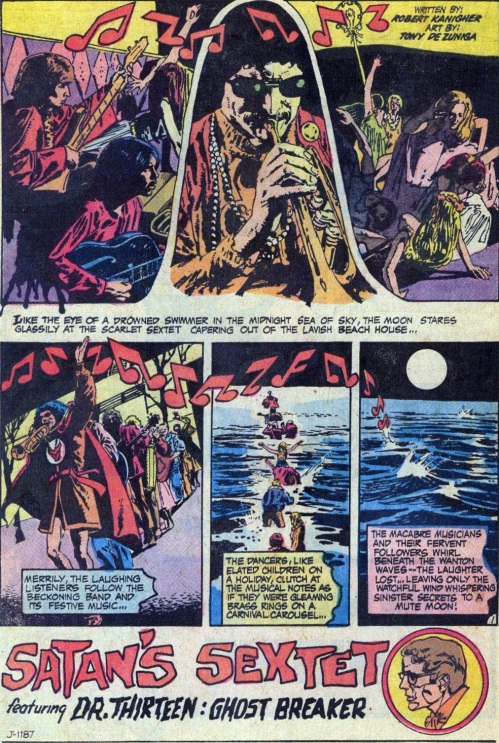
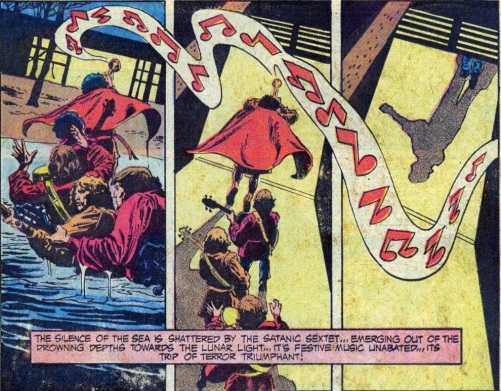

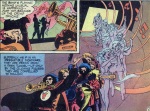
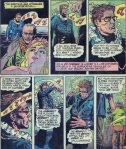


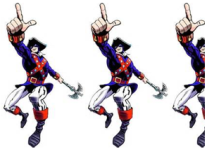








 This is a fun adventure, though it shrinks the scope of the story a bit from the previous issue. It’s always enjoyable to watch these two sets of heroes go into action together, and everyone in the Earth-2 group gets something to do. The action scenes are nicely balanced that way. Yet, Friedrich doesn’t bring too much color or depth to their interactions, with the exception of the incongruous generational conflict from the previous issue. He does bring that weird forced drama between the Hawks and the Robins to a conclusion, with everyone shaking hands and parting friends. That element continues to feel rather pointless, and even the characters themselves seem to have little time for it. Unfortunately, this yarn once again displays the rather sappy tendencies of “Touchy-Feely” Friedrich, but his excesses aren’t too noticeable in this outing.
This is a fun adventure, though it shrinks the scope of the story a bit from the previous issue. It’s always enjoyable to watch these two sets of heroes go into action together, and everyone in the Earth-2 group gets something to do. The action scenes are nicely balanced that way. Yet, Friedrich doesn’t bring too much color or depth to their interactions, with the exception of the incongruous generational conflict from the previous issue. He does bring that weird forced drama between the Hawks and the Robins to a conclusion, with everyone shaking hands and parting friends. That element continues to feel rather pointless, and even the characters themselves seem to have little time for it. Unfortunately, this yarn once again displays the rather sappy tendencies of “Touchy-Feely” Friedrich, but his excesses aren’t too noticeable in this outing.











 At a remote spot on the edge of the city, lovely Claudia Shane decoys the guards by faking a stalled car, only to gas them with the help of New Genesis technology (Note the wonderfully distinctive yet visual consistency with which Kirby depicts even something as simple as a switch). With the way clear, the rest of the gang moves in, and the timid businessman Victor Lanza confronts the local Intergang headman, “Country Boy,” pretending to be the consigliere of the “O’Ryan Mob.” He bluffs the apparently not-too-bright boss into showing off the incredible hi-tech device that Darkseid entrusted to him, allowing Orion to destroy it. Man, Darkseid is so going to kill that guy.
At a remote spot on the edge of the city, lovely Claudia Shane decoys the guards by faking a stalled car, only to gas them with the help of New Genesis technology (Note the wonderfully distinctive yet visual consistency with which Kirby depicts even something as simple as a switch). With the way clear, the rest of the gang moves in, and the timid businessman Victor Lanza confronts the local Intergang headman, “Country Boy,” pretending to be the consigliere of the “O’Ryan Mob.” He bluffs the apparently not-too-bright boss into showing off the incredible hi-tech device that Darkseid entrusted to him, allowing Orion to destroy it. Man, Darkseid is so going to kill that guy.
 With the jammer destroyed, Mother Box is able to pinpoint one of Seagrin’s killers, the leader of the devious Deep Six, Darkseid’s aquatic shock troopers. Setting out to challenge this fiend, known as Slig, the Dog of War heads into the sea, but his foe is ready for him. Apparently the Six have the power to mutate sealife into vicious and useful forms, and Slig uses this ability to capture Orion in grasping tendrils of seaweed. The warrior is able to escape by triggering the Astro-Force, but it is a desperate and dangerous maneuver that leaves him stunned. And it is there that our tale ends!
With the jammer destroyed, Mother Box is able to pinpoint one of Seagrin’s killers, the leader of the devious Deep Six, Darkseid’s aquatic shock troopers. Setting out to challenge this fiend, known as Slig, the Dog of War heads into the sea, but his foe is ready for him. Apparently the Six have the power to mutate sealife into vicious and useful forms, and Slig uses this ability to capture Orion in grasping tendrils of seaweed. The warrior is able to escape by triggering the Astro-Force, but it is a desperate and dangerous maneuver that leaves him stunned. And it is there that our tale ends!




 The cover for this issue sets the stage well enough, even if its not a particularly compelling image (and the lines of its ‘ceiling’ don’t quite make sense). For once, the promise of the cover is delivered within, though the tale begins in more traditional fashion. Young Clark’s ‘Earthday’ celebration with his parents is interrupted by reports that the
The cover for this issue sets the stage well enough, even if its not a particularly compelling image (and the lines of its ‘ceiling’ don’t quite make sense). For once, the promise of the cover is delivered within, though the tale begins in more traditional fashion. Young Clark’s ‘Earthday’ celebration with his parents is interrupted by reports that the 
 Not quite. After a nice two-page spread in which Superboy is attacked by strange weapons mounted on the old ships, only to disable them with his freeze-breath, the Boy of Steel is confronted by a video message from the author of these strange events. The prosaically named “Cerebron” (I wonder what his gimmick could be) declares that he was controlling the fleet and begins to make some threats before we cut away to the young hero towing the frozen fleet away. Yet, the storytelling breaks down a bit here, and the fact that the conversation continued between panels isn’t really obvious, which actually caused me some confusion when I read this yarn.
Not quite. After a nice two-page spread in which Superboy is attacked by strange weapons mounted on the old ships, only to disable them with his freeze-breath, the Boy of Steel is confronted by a video message from the author of these strange events. The prosaically named “Cerebron” (I wonder what his gimmick could be) declares that he was controlling the fleet and begins to make some threats before we cut away to the young hero towing the frozen fleet away. Yet, the storytelling breaks down a bit here, and the fact that the conversation continued between panels isn’t really obvious, which actually caused me some confusion when I read this yarn.
 Back in Smallville, Pa Kent is busy loading up produce for his general store (I always forget that he had this store in this era of the comics), when Superboy suddenly swoops in with the police hot on his heels. The Boy of Might declares that Kent is selling tainted food, and the police haul him away. Tests prove that the youth’s accusation is accurate, and the Kents are locked up. I’ll give Dorfman partial credit. While Ma Kent does the usual “how could he treat us like this!” bit, Pa is more level-headed and points out that there must be a good reason. After all, they know their son wouldn’t hurt them intentionally. Now, if only the payoff will justify his faith…
Back in Smallville, Pa Kent is busy loading up produce for his general store (I always forget that he had this store in this era of the comics), when Superboy suddenly swoops in with the police hot on his heels. The Boy of Might declares that Kent is selling tainted food, and the police haul him away. Tests prove that the youth’s accusation is accurate, and the Kents are locked up. I’ll give Dorfman partial credit. While Ma Kent does the usual “how could he treat us like this!” bit, Pa is more level-headed and points out that there must be a good reason. After all, they know their son wouldn’t hurt them intentionally. Now, if only the payoff will justify his faith…


 Over the next few days, the hero and villain play cat and mouse, with Cerebron finding his foe each time Superboy establishes a new base. Apparently, every time the Boy of Steel tries to attack Cerebron, his ship vanishes…and somehow the kid with a zillion types of vision can’t find it. Of course, all this time, Ma and Pa Kent are rotting in jail. Finally, our young hero decides to set a trap for his persistent enemy, and he establishes a base in an wrecking yard, which he seals when Cerebron’s invisible ship enters. Once again, why X-Ray vision can’t detect the ship is anyone’s guess. Despite not being able to see the sinister Cerebron, Clark comes up with a clever solution. He just uses his heat vision to turn the inside of the base into an oven and forces the villain to surrender or be cooked.
Over the next few days, the hero and villain play cat and mouse, with Cerebron finding his foe each time Superboy establishes a new base. Apparently, every time the Boy of Steel tries to attack Cerebron, his ship vanishes…and somehow the kid with a zillion types of vision can’t find it. Of course, all this time, Ma and Pa Kent are rotting in jail. Finally, our young hero decides to set a trap for his persistent enemy, and he establishes a base in an wrecking yard, which he seals when Cerebron’s invisible ship enters. Once again, why X-Ray vision can’t detect the ship is anyone’s guess. Despite not being able to see the sinister Cerebron, Clark comes up with a clever solution. He just uses his heat vision to turn the inside of the base into an oven and forces the villain to surrender or be cooked.

 Finally, Superboy captures the clever criminal, unmasking him as Lex Luthor in the process. We are also treated to an explanation of the story, with Lex reminding us that he hates Superboy because he made him bald. What an utterly ludicrous motivation for a great villain! The whole bald angle is a great extra element to the character, illustrating as it does Lex’s pride and vanity, but it should really be ancillary. It’s just so hilariously absurd that it’s treated as the entire motivation in some of these stories. Nonetheless, baldy’s plan wasn’t bad this time. The fleet was a diversion, and its guns really just coated Superboy in radiation that his nemesis could track. During the unclear intermission where Cerebron threatened the hero, we see that he claims to have figured out the Boy of Steel’s secret identity and promises to kill the Kents if he interferes again. Thus, Clark faked their arrest in order to protect them…which is fine, but why in the world would he not tell them? Apparently, the police knew all about it, so it seems that he can trust the police to keep the secret, but not his own parents. That’s just sloppy writing, which is to be expected from Dorfman.
Finally, Superboy captures the clever criminal, unmasking him as Lex Luthor in the process. We are also treated to an explanation of the story, with Lex reminding us that he hates Superboy because he made him bald. What an utterly ludicrous motivation for a great villain! The whole bald angle is a great extra element to the character, illustrating as it does Lex’s pride and vanity, but it should really be ancillary. It’s just so hilariously absurd that it’s treated as the entire motivation in some of these stories. Nonetheless, baldy’s plan wasn’t bad this time. The fleet was a diversion, and its guns really just coated Superboy in radiation that his nemesis could track. During the unclear intermission where Cerebron threatened the hero, we see that he claims to have figured out the Boy of Steel’s secret identity and promises to kill the Kents if he interferes again. Thus, Clark faked their arrest in order to protect them…which is fine, but why in the world would he not tell them? Apparently, the police knew all about it, so it seems that he can trust the police to keep the secret, but not his own parents. That’s just sloppy writing, which is to be expected from Dorfman.

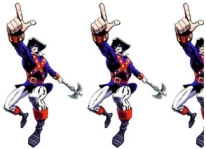














 In the speed dimension, the Sentinel tells Flash that the strange place is being attacked by a being he calls the Devourer, which is trying to tear its way into the hero’s universe. The being takes a number of random forms, shifting rapidly, including a giant rat, ram, blowtorch, and T-Rex. All of the Scarlet Speedster’s attacks are ineffective, but he finally reasons that, since the normal physical laws don’t apply in this bizarre place, he should try something completely random that would be ineffective in his home dimension.
In the speed dimension, the Sentinel tells Flash that the strange place is being attacked by a being he calls the Devourer, which is trying to tear its way into the hero’s universe. The being takes a number of random forms, shifting rapidly, including a giant rat, ram, blowtorch, and T-Rex. All of the Scarlet Speedster’s attacks are ineffective, but he finally reasons that, since the normal physical laws don’t apply in this bizarre place, he should try something completely random that would be ineffective in his home dimension.



 In a fun bit of detail, he notes that when he started out he expected to be stumbling over heists all the time, but unlike in “comic mags,” such things have proven rare. Yet, when he goes to eject his costume from his ring, a strange gas emerges instead, knocking him out!
In a fun bit of detail, he notes that when he started out he expected to be stumbling over heists all the time, but unlike in “comic mags,” such things have proven rare. Yet, when he goes to eject his costume from his ring, a strange gas emerges instead, knocking him out!













 Then Kirby’s inimitable imagination is on strange and unsettling display as he takes us on a tour of the torments Desaad has devised for our young heroes. First, Mark Moonrider is locked in another glass prison, this one rendering him as an animated skeleton to the people passing below. Big Bear, for his part, is in a shooting gallery where the park-goers see him as a robotic bear, and their each shot creates a cacophony of sonic chaos within his cell. Beautiful Dreamer has a more sedate torture in store for her, as the uber-creepy master masochist paralyzes her and inserts her into a glass coffin, where the illusion works in the opposite way of the others, rendering the harmless civilians who regard her as hideous monsters waiting to devour the helpless damsel.
Then Kirby’s inimitable imagination is on strange and unsettling display as he takes us on a tour of the torments Desaad has devised for our young heroes. First, Mark Moonrider is locked in another glass prison, this one rendering him as an animated skeleton to the people passing below. Big Bear, for his part, is in a shooting gallery where the park-goers see him as a robotic bear, and their each shot creates a cacophony of sonic chaos within his cell. Beautiful Dreamer has a more sedate torture in store for her, as the uber-creepy master masochist paralyzes her and inserts her into a glass coffin, where the illusion works in the opposite way of the others, rendering the harmless civilians who regard her as hideous monsters waiting to devour the helpless damsel.





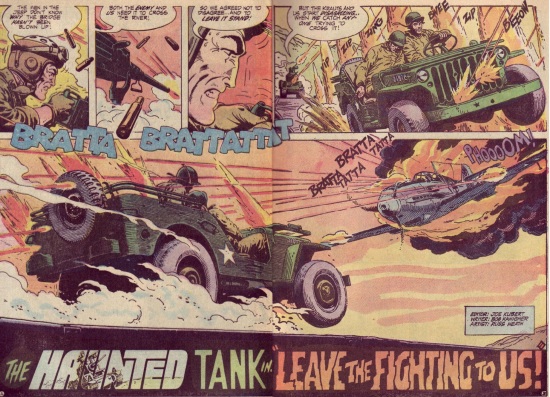




























 The hero has suddenly become overbearing, brash, and more than a little selfish, and he begins to handle even the most minor of crimes with outlandish responses, like when he picks up a speeding car and deposits it on top of the Empire State Building (like I said, we’re suddenly in New York). He also meets I-Ching up there at the blind man’s request. The mystic points out this strange behavior and tells Superman that he thinks the Man of Tomorrow suffered brain damage when he was mortal, which enrages the hero. Unable to convince the Metropolis Marvel that something is wrong, I-Ching turns again to magic, all the while talking about how it is a really bad idea because he doesn’t really know what he’s doing. I knew they should have contacted Dr. Fate!
The hero has suddenly become overbearing, brash, and more than a little selfish, and he begins to handle even the most minor of crimes with outlandish responses, like when he picks up a speeding car and deposits it on top of the Empire State Building (like I said, we’re suddenly in New York). He also meets I-Ching up there at the blind man’s request. The mystic points out this strange behavior and tells Superman that he thinks the Man of Tomorrow suffered brain damage when he was mortal, which enrages the hero. Unable to convince the Metropolis Marvel that something is wrong, I-Ching turns again to magic, all the while talking about how it is a really bad idea because he doesn’t really know what he’s doing. I knew they should have contacted Dr. Fate!


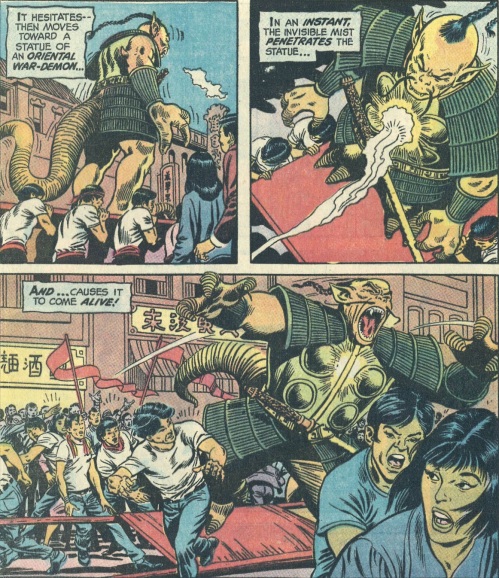








 This gambit seems to have worked for a time, but on another stormy night, Rune once again sees the Stranger stalking out of the darkness. In desperation, his servant, Rashid, who had originally trapped the mysterious hero, tries to conjure another spell to banish his spirit. Unfortunately, his power is not up to the task, and in the midst of his incantations, the Stranger appears! Despite the loyal Hindu’s desperate efforts, when Rune flees out into the storm, the Spectral Sleuth follows, and the stolen heart stops beating! Finally, Rune’s allies find him, dead, and lacking a heart!
This gambit seems to have worked for a time, but on another stormy night, Rune once again sees the Stranger stalking out of the darkness. In desperation, his servant, Rashid, who had originally trapped the mysterious hero, tries to conjure another spell to banish his spirit. Unfortunately, his power is not up to the task, and in the midst of his incantations, the Stranger appears! Despite the loyal Hindu’s desperate efforts, when Rune flees out into the storm, the Spectral Sleuth follows, and the stolen heart stops beating! Finally, Rune’s allies find him, dead, and lacking a heart!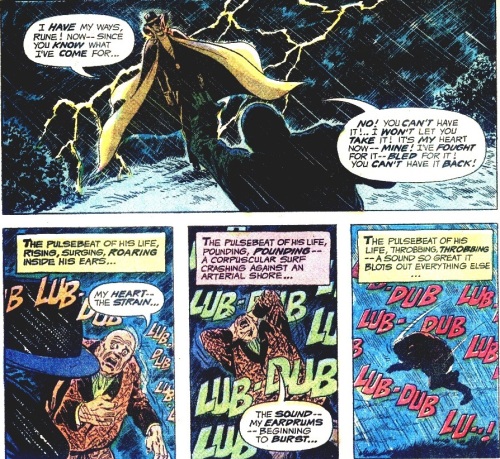
















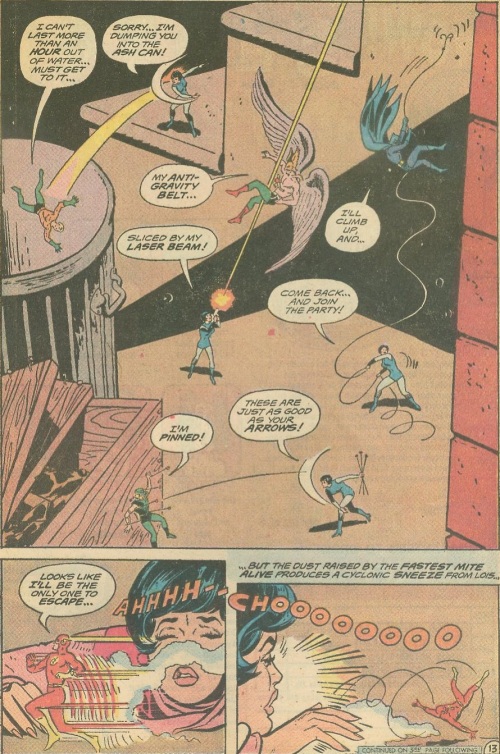












 Unfortunately, only Superman, Jimmy, and the Guardian make the trip in the Whiz Wagon, while the kids remain behind, quarantined and due to be tested because Gabby picked up a cold. Isn’t that sort of closing the barn door after the cows have gotten out, especially if you let the others go? Nonetheless, the scene is pretty funny, as Gabby’s fellows pelt him with newspapers for landing them in stir. Note Flippa Dippa who, for reasons known only to himself and Kirby’s fevered imagination, is wearing his wetsuit under his hospital gown. Their salvation comes in a strange but entertaining form, as Scrappy finds one of the tiny mini-Scrapper paratroopers has hitched a ride in his hair and agrees to help them break out.
Unfortunately, only Superman, Jimmy, and the Guardian make the trip in the Whiz Wagon, while the kids remain behind, quarantined and due to be tested because Gabby picked up a cold. Isn’t that sort of closing the barn door after the cows have gotten out, especially if you let the others go? Nonetheless, the scene is pretty funny, as Gabby’s fellows pelt him with newspapers for landing them in stir. Note Flippa Dippa who, for reasons known only to himself and Kirby’s fevered imagination, is wearing his wetsuit under his hospital gown. Their salvation comes in a strange but entertaining form, as Scrappy finds one of the tiny mini-Scrapper paratroopers has hitched a ride in his hair and agrees to help them break out.


 Shortly thereafter, Clark and Jimmy arrive, demanding to see Edge, but they get sent out on the same assignment, arriving at the park in short order. There they find a strange craft, and when Clark investigates, Goody moronically starts pressing buttons, suddenly causing the device to vanish! The remaining protagonists are then attacked by Intergang thugs, and the Guardian goes into action while Goody says things that are ostensibly supposed to be funny. The cloned champion gives a good showing, tearing through his assailants, and even Jimmy gives a good account of himself. Kirby has him keep his foes busy through athleticism and cleverness rather than simply outbrawling them, which is fitting. Goody does a comedy routine as he accidentally thwarts the bad guys. Unfortunately, all their efforts are for naught, as one of Intergang’s bigwigs, the aptly named
Shortly thereafter, Clark and Jimmy arrive, demanding to see Edge, but they get sent out on the same assignment, arriving at the park in short order. There they find a strange craft, and when Clark investigates, Goody moronically starts pressing buttons, suddenly causing the device to vanish! The remaining protagonists are then attacked by Intergang thugs, and the Guardian goes into action while Goody says things that are ostensibly supposed to be funny. The cloned champion gives a good showing, tearing through his assailants, and even Jimmy gives a good account of himself. Kirby has him keep his foes busy through athleticism and cleverness rather than simply outbrawling them, which is fitting. Goody does a comedy routine as he accidentally thwarts the bad guys. Unfortunately, all their efforts are for naught, as one of Intergang’s bigwigs, the aptly named 



 Goody’s indignation, not at the murder attempt, but at being dropped off out of his way is genuinely funny, but it’s one of the few moments in this comic that can actually be described that way. He’s more grating and bizarre than humorous, with some of his dialog reminding you of a joke in the way that a badly hummed tune can remind you of a song. There are elements in common, but the effect is rather different. The story itself has a lot of good qualities. However silly the setup, the Newsboy Legion making their escape is pretty fun, as is their banter. Ugly Mannheim is instantly memorable, and the sequence with his unusual methods of dealing with his prisoners is actually quite good. It’s nice to see the Guardian in action again as well, but all of this is overshadowed for some reason by the utterly incongruous presence of Goody, who makes no real sense and just doesn’t fit in this story. Kirby’s art is quite good in this issue, unlike the last New Gods, and he turns in a lot of lovely and energetic moments, as well as some great character work with the Legion. In the end, it’s rather hard to rate this issue, as it is just so very strange and feels more like two separate stories mashed together than a coherent whole. I suppose I’ll give this mad mess 2.5 Minutemen, as the good elements are strong enough to partially offset the perplexing presence of ‘Goody’ Rickles. It’s still a fun read, and interesting in context, but boy is it strange.
Goody’s indignation, not at the murder attempt, but at being dropped off out of his way is genuinely funny, but it’s one of the few moments in this comic that can actually be described that way. He’s more grating and bizarre than humorous, with some of his dialog reminding you of a joke in the way that a badly hummed tune can remind you of a song. There are elements in common, but the effect is rather different. The story itself has a lot of good qualities. However silly the setup, the Newsboy Legion making their escape is pretty fun, as is their banter. Ugly Mannheim is instantly memorable, and the sequence with his unusual methods of dealing with his prisoners is actually quite good. It’s nice to see the Guardian in action again as well, but all of this is overshadowed for some reason by the utterly incongruous presence of Goody, who makes no real sense and just doesn’t fit in this story. Kirby’s art is quite good in this issue, unlike the last New Gods, and he turns in a lot of lovely and energetic moments, as well as some great character work with the Legion. In the end, it’s rather hard to rate this issue, as it is just so very strange and feels more like two separate stories mashed together than a coherent whole. I suppose I’ll give this mad mess 2.5 Minutemen, as the good elements are strong enough to partially offset the perplexing presence of ‘Goody’ Rickles. It’s still a fun read, and interesting in context, but boy is it strange.












































 Meanwhile, on Earth Orion and his rescued human friends make plans to combat Darkseid’s terrestrial forces. The various mortals each get a little characterization, and Kirby does a good job of developing them in a small space, but they remain largely unused. As the Dog of War steps aside to put on some native clothes, he ponders his handsome visage, and we learn that Mother Box has reshaped his features to help him blend in on New Genesis and that his actual face is far more brutal and ugly than the one he shows to the world. Orion, like his readers, wonders what this means about his origins. It’s an intriguing scene. His disguises, both guise and garments, in place, he rejoins his friends.
Meanwhile, on Earth Orion and his rescued human friends make plans to combat Darkseid’s terrestrial forces. The various mortals each get a little characterization, and Kirby does a good job of developing them in a small space, but they remain largely unused. As the Dog of War steps aside to put on some native clothes, he ponders his handsome visage, and we learn that Mother Box has reshaped his features to help him blend in on New Genesis and that his actual face is far more brutal and ugly than the one he shows to the world. Orion, like his readers, wonders what this means about his origins. It’s an intriguing scene. His disguises, both guise and garments, in place, he rejoins his friends.








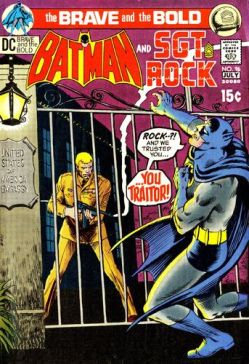

 The story within opens on a dark night in a South American city as a van crashes into a car, the attacking vehicle’s occupants then jumping the stunned passengers. The car’s driver fights back, only to get shot for his trouble, and his passenger is carted away. Back in the U.S., Bruce Wayne is called to Washington D.C. where he is ushered into a secret meeting with the Secretary of State and the P.O.T.O.U.S. himself (that used to be an honor). Nick Cardy does the usual dance, not showing the president’s face, which I enjoy. It turns out the victim from our first scene was Ambassador Adams, who is a friend of Bruce’s, and who was on an important assignment in South America.
The story within opens on a dark night in a South American city as a van crashes into a car, the attacking vehicle’s occupants then jumping the stunned passengers. The car’s driver fights back, only to get shot for his trouble, and his passenger is carted away. Back in the U.S., Bruce Wayne is called to Washington D.C. where he is ushered into a secret meeting with the Secretary of State and the P.O.T.O.U.S. himself (that used to be an honor). Nick Cardy does the usual dance, not showing the president’s face, which I enjoy. It turns out the victim from our first scene was Ambassador Adams, who is a friend of Bruce’s, and who was on an important assignment in South America. He was kidnapped by the “Companeros de La Muerte,” the Companions of Death, and they are holding him for ransom. The President asks Wayne to fill in as a temporary ambassador to complete a delicate treaty, and he introduces Batman, who will travel along as protection. How can this be? Well, it’s Alfred covering for his master in a padded costume, of course, and before long the pair are headed south! This is an interesting setup, and it works surprisingly well considering the stories in the Bat-books relatively recently where Bruce got involved in politics. It’s unusually consistent for Haney…though I’m inclined to wonder if that’s just a coincidence!
He was kidnapped by the “Companeros de La Muerte,” the Companions of Death, and they are holding him for ransom. The President asks Wayne to fill in as a temporary ambassador to complete a delicate treaty, and he introduces Batman, who will travel along as protection. How can this be? Well, it’s Alfred covering for his master in a padded costume, of course, and before long the pair are headed south! This is an interesting setup, and it works surprisingly well considering the stories in the Bat-books relatively recently where Bruce got involved in politics. It’s unusually consistent for Haney…though I’m inclined to wonder if that’s just a coincidence!
 Bruce is struck by the old soldier’s rancor, but he gets on with his job, investigating the scene of the kidnapping as Batman. In search of witnesses, he enters a bull fighting arena and gets a description of the van from a plucky young bullfighter who, in Haney’s trademark flare for minor characters, is full of personality. Strangely, the Dark Knight notices Rock tailing him, just as he is attacked by an assassin! One of the Companeros tries to kill him with a bullfighter’s prop, but the hero’s reflexes prove superior, and the would-be-killer is hoisted by his own petard.
Bruce is struck by the old soldier’s rancor, but he gets on with his job, investigating the scene of the kidnapping as Batman. In search of witnesses, he enters a bull fighting arena and gets a description of the van from a plucky young bullfighter who, in Haney’s trademark flare for minor characters, is full of personality. Strangely, the Dark Knight notices Rock tailing him, just as he is attacked by an assassin! One of the Companeros tries to kill him with a bullfighter’s prop, but the hero’s reflexes prove superior, and the would-be-killer is hoisted by his own petard.












 Fortunately, the Masked Manhunter is always prepared, and he tied a bat-rope to his foot when he climbed to the dizzy height of the steeple, which is a nice, reasonable precaution for the hero to have taken. Outside, he finds the teacher, who was attacked by someone moving fast. She still insists on the innocence of her students, but when the Caped Crusader finds a speaker that provided the eerie bell-toll and traces its cord to a nearby cave, it is indeed the two would be counterculture rebels that he uncovers.
Fortunately, the Masked Manhunter is always prepared, and he tied a bat-rope to his foot when he climbed to the dizzy height of the steeple, which is a nice, reasonable precaution for the hero to have taken. Outside, he finds the teacher, who was attacked by someone moving fast. She still insists on the innocence of her students, but when the Caped Crusader finds a speaker that provided the eerie bell-toll and traces its cord to a nearby cave, it is indeed the two would be counterculture rebels that he uncovers.
 While he is confronting the kids, the bell rings again, but their tape recorder is shut off! Racing back to the church, Batman finds that the bell has been broken free of its rust, a feat that he himself had failed to accomplish. Suddenly, another explosion rocks the town. Interrogating his two captives, who remain defiant, the Dark Knight realizes that someone has been using them as patsies, and by pretending to leave them in the care of the teacher in the cave, he lures out the real culprit…Big Lanny?!
While he is confronting the kids, the bell rings again, but their tape recorder is shut off! Racing back to the church, Batman finds that the bell has been broken free of its rust, a feat that he himself had failed to accomplish. Suddenly, another explosion rocks the town. Interrogating his two captives, who remain defiant, the Dark Knight realizes that someone has been using them as patsies, and by pretending to leave them in the care of the teacher in the cave, he lures out the real culprit…Big Lanny?!

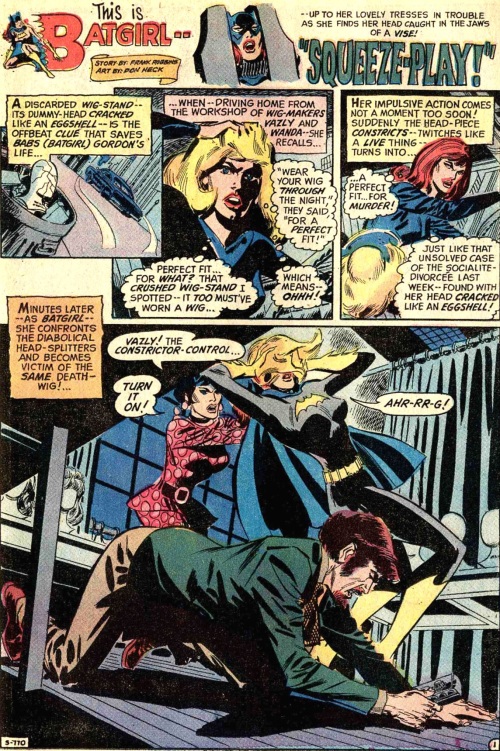






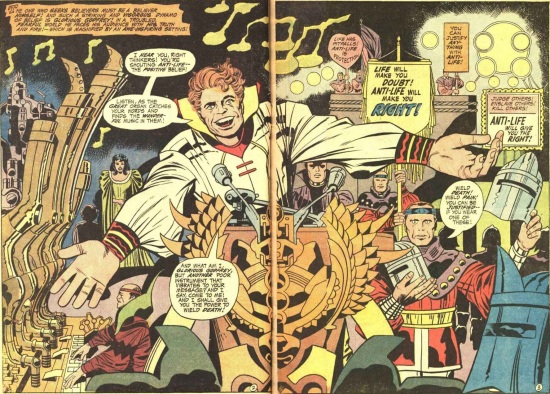













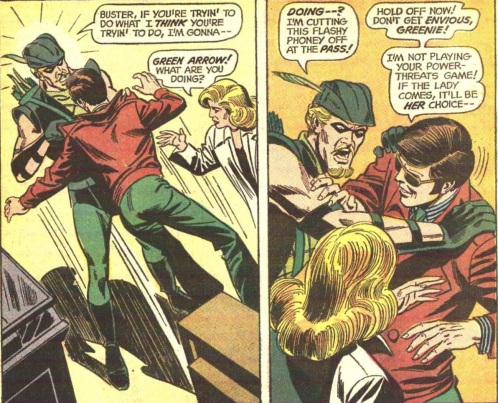

































 He lands with a tremendous impact near Lois, and though he is weakened, he is stills strong enough to carry her and her burden to safety, handily capturing the bandits in the process. Just when it seems like everything is going to be alright, the sandy stranger arrives, finally able to talk after their latest contact, and the dusty doppelganger tells Superman that he is the Kryptonian’s exact equal, and he fears that they cannot both survive! Dun dun DUN!! That’s a pretty solid cliffhanger.
He lands with a tremendous impact near Lois, and though he is weakened, he is stills strong enough to carry her and her burden to safety, handily capturing the bandits in the process. Just when it seems like everything is going to be alright, the sandy stranger arrives, finally able to talk after their latest contact, and the dusty doppelganger tells Superman that he is the Kryptonian’s exact equal, and he fears that they cannot both survive! Dun dun DUN!! That’s a pretty solid cliffhanger.













 Sadly, one of the real weaknesses of the issue is the art, which I really didn’t expect. I’m fairly certain we’re seeing the consequences of having Vinnie Colleta inking all of Kirby’s books. There is a lot of heavy inking, lost detail, and empty backgrounds. There are some muddy, ugly panels as well. Of course, the King’s pencils are not at their best here either, and the really striking moments often share space with some slightly awkward panels, like Mantis’s strange flight pattern during the fight. When the art is good, it’s great, but when it’s bad, the contrast is quite telling. Still, there are some wonderful moments throughout.
Sadly, one of the real weaknesses of the issue is the art, which I really didn’t expect. I’m fairly certain we’re seeing the consequences of having Vinnie Colleta inking all of Kirby’s books. There is a lot of heavy inking, lost detail, and empty backgrounds. There are some muddy, ugly panels as well. Of course, the King’s pencils are not at their best here either, and the really striking moments often share space with some slightly awkward panels, like Mantis’s strange flight pattern during the fight. When the art is good, it’s great, but when it’s bad, the contrast is quite telling. Still, there are some wonderful moments throughout.






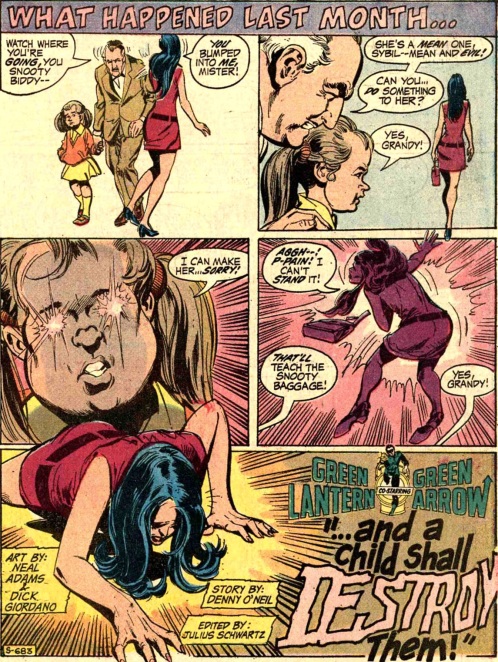







 Prowling the halls, she is discovered by Belmore and Grandy, who attack her, but she easily handles them until the little girl, Sybil, uses her powers to cripple the Canary. Then, unsurprisingly, Grandy removes her wig and discovers her identity. Wow. Who could have ever seen that coming? Notably, O’Neil includes a moment where the Blonde Bombshell reflects that she’s enjoying the violence and notes that she needs to be careful about that, which is interesting, but it’s still presented in the nonsensical context of Dinah ‘hating violence.’
Prowling the halls, she is discovered by Belmore and Grandy, who attack her, but she easily handles them until the little girl, Sybil, uses her powers to cripple the Canary. Then, unsurprisingly, Grandy removes her wig and discovers her identity. Wow. Who could have ever seen that coming? Notably, O’Neil includes a moment where the Blonde Bombshell reflects that she’s enjoying the violence and notes that she needs to be careful about that, which is interesting, but it’s still presented in the nonsensical context of Dinah ‘hating violence.’






